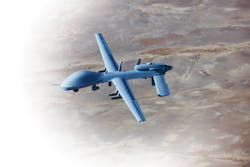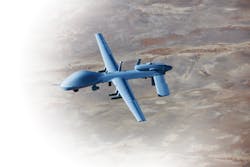General Atomics to build four more Gray Eagle long-endurance attack drones
REDSTONE ARSENAL, Ala. - U.S. Army aviation experts are ordering four MQ-1C Gray Eagle reconnaissance and attack drones, as well as four unmanned aerial vehicle (UAV) satellite control stations.
Officials of the Army Contracting Command at Redstone Arsenal, Ala., announced a $25.3 million contract modification to General Atomics Aeronautical Systems Inc. in Poway, Calif., for Gray Eagle attack drones and satellite communications air data terminals.
The General Atomics MQ-1C Gray Eagle attack drone medium altitude long endurance (MALE) unmanned aircraft is an upgraded MQ-1 Predator as an extended-range multi-purpose UAV. The aircraft can be fitted with the AGM-114 Hellfire missile or GBU-44/B Viper Strike guided bomb for attack missions.
The Gray Eagle UAV has a synthetic aperture radar/ground moving target indicator (SAR-GMTI) system, and targeting capability from an AN/AAS-52 multi-spectral targeting system (MTS) under the nose. The aircraft can carry a payload as heavy as 800 pounds.
The MQ-1C Gray Eagle provides reconnaissance, surveillance, and target acquisition; command and control; communications relay; signals intelligence; electronic warfare; attack; detection of weapons of mass destruction; battle damage assessment; and manned and unmanned teaming capabilities.
Compared with its MQ-1 Predator predecessor, the Gray Eagle has an increased wingspan, and a Thielert Centurion 1.7 heavy-fuel engine (HFE) able to burn jet and diesel fuel. The UAV can fly for as long as 36 hours at altitudes to 25,000 feet. It has an operating range of 200 nautical miles.
Army commanders deploy the Gray Eagle UAV in platoons, each with four aircraft, support equipment, and payloads like electro-optical/infrared/laser range finder/laser designator; communications relay; and as many as four hellfire missiles. The common sensor payload and synthetic aperture radar ground moving target indicator are one per aircraft. Ground equipment per platoon includes two universal ground control stations; three universal ground data terminals; one satellite communication ground data terminal; and one mobile ground control station per company.
General Atomics will build the UAVs in Poway, Calif., and should be finished by December 2017.
FOR MORE INFORMATION visit General Atomics Aeronautical Systems online at www.ga-asi.com.

